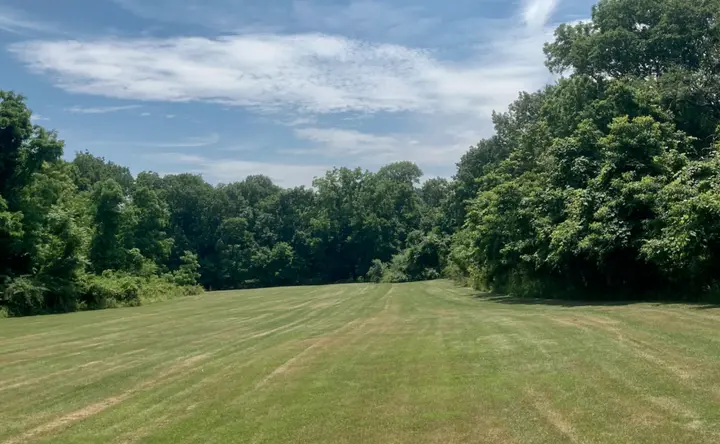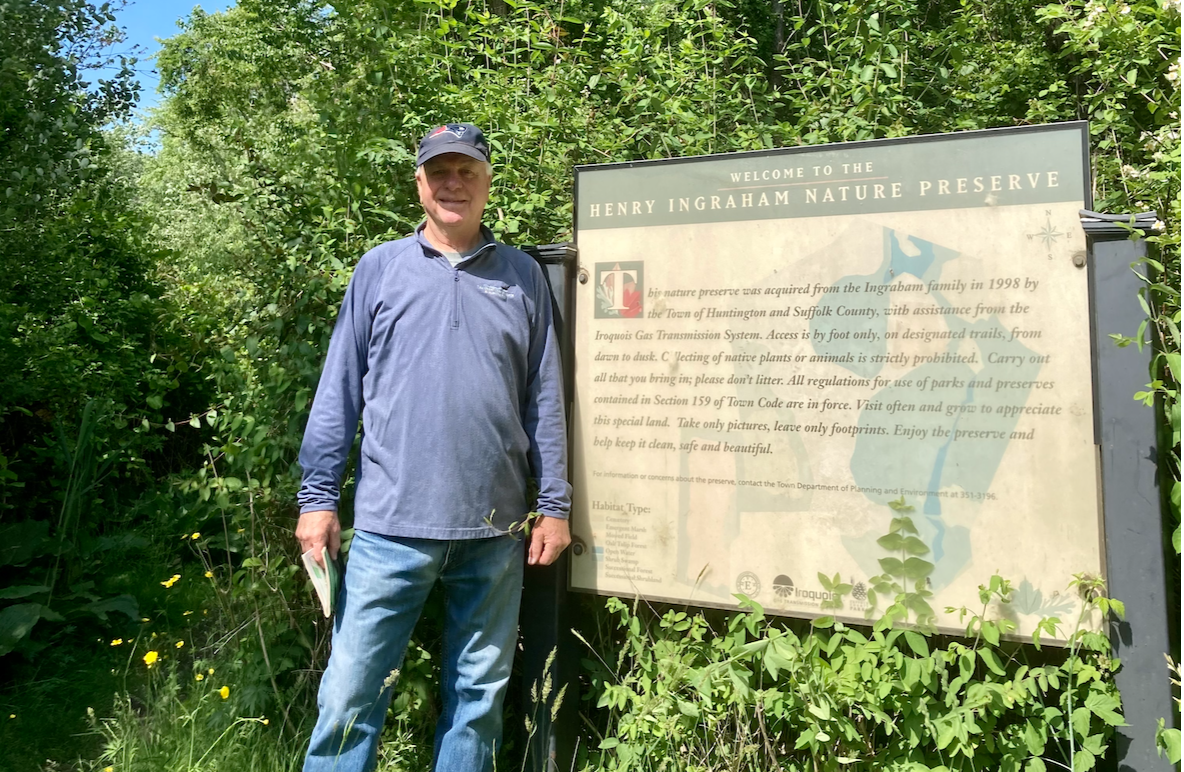Walks in the Woods: Henry Ingraham Preserve

A four-acre field atop the Henry Ingraham Nature Preserve in Northport is just one reason to visit the property, 27 acres of which are open to the public.
Born in 1878 in Brooklyn, New York, Henry A. Ingraham spent some of his time growing up in Locust Valley, where his family had a summer home. As he got older, he would take trips out east, exploring Long Island. Northport caught his eye so much so that, when he had the resources, he returned to town and bought a home of his own.
A naturalist, gardener, and birder, Henry chose a farmhouse on 40 acres of land, located between Eatons Neck Road and Locust Road, and made it his family’s weekend home and summer escape. Today, 27 of those acres are open to the public, acquired from the Ingraham family in 1998 by the Town of Huntington and Suffolk County.
Park steward and grandson to Henry, Rob Ingraham grew up in a house just up the hill on Locust Road and fondly recalls a childhood filled with outdoor adventure: playing football with his brothers on the vast property, sleighing down its snowy hills in the winter. Rob took over his grandparents’ house in 1983 and 15 years later created the deal with the town and county to have a large part of the property made into the Henry Ingraham Nature Preserve.
Last month, I had the great pleasure of walking the trail with Rob; his love for and commitment to the land was evident from the moment we began our hike.
“For our family, it’s a lovely legacy for us to leave, and to have my grandfather, who was so caring about the environment, know that this great parcel of land is to be enjoyed by everybody…” he said. “Everything is meant to be shared.”
What the preserve now shares with visitors is diverse, and plentiful: ponds, streams, wetlands, an open field and Revolutionary War-era cemetery, many different species of trees, Harbor Hill Moraine, and enough birdlife to make it a longtime favorite of the local Audubon Society. It truly is a hidden gem.
Located on a gentle slope in the northeast corner of the preserve, and the first stop for visitors entering through its main entrance on Waterside Road, is Crabmeadow Burying Ground, sometimes referred to as Burying Hill. The reason the path from the road was created in the first place, explained Rob, was because there had to be a way to bring the dead in.
The cemetery dates back to 1738, and includes a re-creation of a Revolutionary War headstone. Small American flags have been staked by the side of some tombstones, while the remnants of others lay scattered on the ground, broken during a long wave of vandalism from the 1960s to 1980s. When attempts to restore the cemetery proved too difficult, a large stone monument was installed on the property, dedicated in 2003 to the families buried in the cemetery.
“More than 150 residents of Crabmeadow were laid to rest on this hillside between 1738 and 1892,” reads the engraving on the stone. “Time, weather and vandalism have destroyed their individual markers. This monument was erected to honor their memory.”
From the cemetery, visitors can follow a few easy-to-walk loops, including one cleared out and created by Rob and his wife June, to offer visitors more options and more space during Covid. As park steward, Rob walks his dogs through part of the trails several times a day, and is determined to keep the paths open and accessible to visitors. He and his family, as well as friends and neighbors who volunteer their time, do much of the trail maintenance, upkeep, and updates themselves.
Rob stopped at a picturesque pond on the property, where birds and wildlife gather at the headwaters that lead north to the wetlands and Crab Meadow’s Jerome A. Ambro Wetland Preserve. The idyllic spot, he noted, was photographed and used in the Town of Huntington Trails Guide.
Keep steady up the preserve’s hills to explore the property’s multiple levels – on the upper trail, benches made by Eagle Scouts offer a relaxing place to take in water views in the fall. It felt nice to gain some elevation on the walk, and distinct vantage points from which to view the area.
While you’re on the preserve’s upper trail take a detour (or plan your day around) a four-acre field, where horses used to graze, now open to the public for picnicking, frisbee-throwing, or a catch with the kids. There isn’t much respite from the sun on a hot day, but the land, so open, so available, should be a welcome find for anyone who appreciates peace and quiet, or is just looking for a little solitude to sit back and relax.
When I first spoke with Rob, on the phone before our walk, he said he looked forward to giving me a tour of the preserve, his knowledge and pride for the property already apparent.“Hopefully you’ll depart enriched, as my mother would say,” he said.
It’s hard not to.
Length: Up to you. Keep it short or make it longer by exploring neighboring preserves, Fuchs Pond and Makamah, just on the other side of Waterside.
Terrain: Hills with slight elevation.
Noise levels: Minimal (passing cars on Waterside and Eaton’s Neck Road, drowned out by bird calls on a good day).
Parking: Street (there’s a small lot just south of Eaton’s Neck Road, on the west side of Waterside Road, that fits three or four cars and almost always has room).
Tips: Pack tick spray, sunblock, a snack and something to have a catch with, and find that field. Also, be a good neighbor, and carry out all that you bring in.
Harbor Hill what? Rob Ingraham mentioned Harbor Hill Moraine as one of the preserve’s many attributes. Confession: I don’t know what that is. The New York Times offered this explanation in a 2003 article about the area: Northport is situated on one of several necks along the morainal north shore of Huntington. Glaciers moving southward sculpted the peninsula-like necks and adjacent deep harbors some 20,000 years ago. The retreating glaciers left behind kames, small hills made of glacial sediments, and kettle holes, formed by imbedded blocks of melting ice. They dot the landscape at the Henry Ingraham Nature Preserve in Northport. The hilly terrain, except for areas sculpted by sand mining, is another legacy.
What about the Mrs.? Also born in Brooklyn, Henry’s wife, Mary Shotwell Ingraham, was an educator and civic leader, active in many organizations that promoted social welfare. In 1946, she was awarded the Presidential Medal for Merit by Harry Truman, becoming the first woman to receive the honor. According to the Northport Historical Society, Mary was president of the YWCA in 1941, when President Franklin D. Roosevelt sought to unite several service associations into one organization with the goal of lifting morale in the military and on the home front. Mary, along with the heads of the Salvation Army, the YMCA, National Catholic Community Services, National Travelers Aid Association, and National Jewish Welfare Board, worked to create the United Service Organizations, or USO, an important part of the war effort during WWII.
For additional information, including a map of the Henry Ingham Nature Preserve, see the TOH trail guide.
Before this: Fuchs Pond Preserve
Up next: Send your suggestions to joanne@northportjournal.com.

Don’t miss a story
Get the latest news delivered to your inbox.








